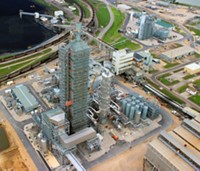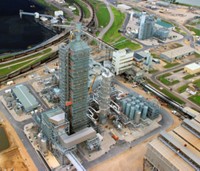Advertisement
Grab your lab coat. Let's get started
Welcome!
Welcome!
Create an account below to get 6 C&EN articles per month, receive newsletters and more - all free.
It seems this is your first time logging in online. Please enter the following information to continue.
As an ACS member you automatically get access to this site. All we need is few more details to create your reading experience.
Not you? Sign in with a different account.
Not you? Sign in with a different account.
ERROR 1
ERROR 1
ERROR 2
ERROR 2
ERROR 2
ERROR 2
ERROR 2
Password and Confirm password must match.
If you have an ACS member number, please enter it here so we can link this account to your membership. (optional)
ERROR 2
ACS values your privacy. By submitting your information, you are gaining access to C&EN and subscribing to our weekly newsletter. We use the information you provide to make your reading experience better, and we will never sell your data to third party members.
Environment
Sooner Is Better For Coal Emissions Scrubbing
Capturing Carbon: Removing greenhouse gases from coal-powered electricity generation—and starting now—could mean major benefits
by Mark Schrope
August 13, 2012
CORRECTION: This story was updated on Aug. 20, 2012, to reflect Eric Masanet’s new affiliation.
If coal-fired power plants began now to deploy systems for capturing and storing greenhouse gases, they’d see a drop in efficiency, requiring them to burn more coal to meet electricity needs. Still, doing so would prevent enough greenhouse gas emissions to have a substantial climate payoff by 2100, according to a new climate modeling study (Environ. Sci. Technol., DOI: 10.1021/es3006332)

Coal is the largest source of electricity generation in the U.S., and with plant life spans up to 75 years, that won’t change quickly. Unfortunately, burning coal produces copious greenhouse gases. Capturing and sequestering carbon dioxide and other greenhouse gases, at existing plants and new ones, is technically feasible but remains difficult and expensive. Regulators want to understand the potential benefits of such efforts as they decide whether to mandate such carbon capture and storage (CCS).
Past studies modeling the atmospheric effects of broadly applying CCS have generally looked no further than 2050. After 2050, variables such as energy demands and available technologies become too uncertain. “We wanted to analyze up to there and beyond,” says Roger Sathre, an environmental scientist at the Lawrence Berkeley National Laboratory, who led the new study. Despite the uncertainties, he thought, going further into the future could reveal potentially important phenomena.
Considering coal plants in the continental U.S., he and coauthor Eric Masanet, now at Northwestern University, modeled how three CCS installation scenarios would contribute to the global climate through 2100: no use of CCS, application of CCS only at new power plants, and CCS use at new plants in conjunction with retrofitting existing plants where feasible. Among other parameters, they considered the scenarios’ effects on cumulative radiative forcing—how much the captured gas would have heated the atmosphere if it had been released.
The researchers found that, compared to no action, the early retrofit scenario reduced long-term heating by nearly 50% Outfitting only new plants reduced heating by about 25%. The reason for the large difference in results is that carbon dioxide lasts for roughly 100 years in the atmosphere, Sathre explains: Any gases not removed by scrubbers early on in the model’s span heat the atmosphere throughout the rest of the century.
Because of CO2’s long lifetime and other factors, such as improving CCS technologies, the researchers found that the differences among scenarios became especially pronounced after the year 2050.
Installing CCS systems does have a downside for plants, Sathre says. Existing capture technologies cause major decreases in plant efficiency, he points out, meaning they have to burn more coal to produce the same amount of electricity. While this efficiency decrease would raise the amount of coal burned, the researchers found that capture equipment would prevent a major associated emissions increase.
The study is “certainly timely,” says Eric Eddings, an engineer at the University of Utah, because of ongoing political debate over how to address climate change. He says deployment of CCS systems would involve countless political hurdles: Plant operators, he says, don’t want to invest in the technology unless the law requires them to do so.




Join the conversation
Contact the reporter
Submit a Letter to the Editor for publication
Engage with us on Twitter